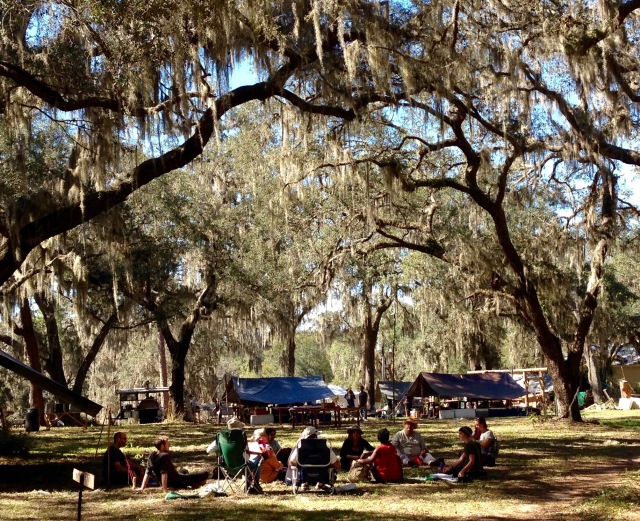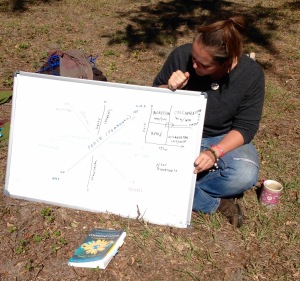
Sitting under Live Oaks was a relaxing setting as we talked about more effective interactions with others in conflict situations.
Peacemaking
That was the title of the class that caught my attention as I looked through the classes being offered at the Florida Earthskills Gathering. Yes, there were other interesting classes – from Natural Dyeing to Knot Tying to Healing with Water. But peacemaking spoke to me.
That’s what led to me sitting in a circle with 14 others under a canopy of Live Oak trees on a sunny day at the Little Orange Creek Nature Park on the outskirts of Hawthorne, Florida.

Sara Callaway used a whiteboard to draw the Eight Shields that demonstrate the dynamics of interactions that can lead to conflict — or that can help us, by recognizing those issues, reach collaborative solutions.
Sara Callaway, the session leader who has been attending Earthskills for 15 years, had us start by taking some deep breathes and clearing our minds. We went around the circle, introducing ourselves and briefly saying why we had chosen to attend this session.
- Family friction and conflicts
- Current political climate
- Difficulties at work
Those were the issues that were listed by the group’s participants – and that’s the order in terms of the frequency of mention.
We spent a fast two hours talking about factors that contribute to differences in views on issues (from who should be planning the family reunion to discussing differences in political opinions) and strategies that can be used to promote peacemaking. Sara provided information and explanations, promoted active engagement, and offered strategies. People shared stories and asked questions.
Here are some of the major take-aways.
Strive for personal calmness – A goal Sara reinforced throughout the session was the importance of each of us having a “quiet mind” and looking for ways to promote peace in our own actions.
We discussed how difficult it can be to try and have that quiet mind and be in the moment. Certainly a downside of technology like smartphones is that we can be constantly interrupted. Even while pumping gas, your thinking can be interrupted by Gas Station TV, which launches into news and ads as you start the pump.
The group discussed ways we had found to help has time for yourself – meditating, walking in nature, praying, running, reading poetry, singing. A mom with three children, including an infant, tried to explain to some of the group’s participants why finding time for herself was hard to do.
Create positive experiences – Sara encouraged creating “glue times.” For example, create family situations where everyone can enjoy being together – going to a movie or for a walk or playing a game. Having those common, positive times can help move from the feeling that every time people get together – whether at a meeting at work or in a personal relationship – will be a negative experience.
Look for the opportunity to plant a seed – Sara said that change doesn’t usually occur in one instance. You want to look for times when you can mention something in a non-confrontational way that others can think about without having to action right then. That can lead to a conversation later after the person has had time to think about what you’ve said.
Become familiar with your own baggage – If you realize that you are reacting more strongly to a comment than would seem appropriate, evaluate where your reaction is coming from. Your emotion may be triggered by an event from years ago or from a series of small situations that have been building.
Think about your role in a difficult conversation – Sara said that every conversation has a pitcher and a catcher. You should “throw” something that the other person can catch. And repeating back what the other person has said can show that you are listening and enable the other person to rephrase or clarify if you haven’t correctly understood what they are saying. (But you also can’t do that reflecting back in a way that irritates the other person.)
Use the Eight Shields of Peacemaking – Sara shared the Eight Shields that illustrates the complexity of issues that affect us in our interactions. The Shields include Ancestral (racial, ethnic, gender, socio-economic, etc.), Power (physical, economic, etc.), Appreciation (feeling appreciated by others and having others respond to our needs). Realizing those issues can help us understand our own perspective on issues and the perspectives of others. That can help us adjust how we approach a person or situation.
One of the big challenges in implementing peacemaking strategies is being able in the moment to respond in a way that is different than how we have handled similar situations in the past. Listening differently. Speaking differently. That can be hard to do in the heat of the moment.
If we had more time, I would have found it useful to have some role playing, with us working through difficult scenarios we’ve experienced and finding different ways to respond than what we’ve been doing.
Sara and several others in the group recommended Marshall B. Rosenber’s “Nonviolent Communication: Create Your Life, Your Relationships, and Your World in Harmony with Your Values.” I’ve since read the book and found it useful.
Changing your approach to dealing with conflict (or potential conflict) requires that you have a peaceful mindset and a willingness to work toward a collaboration, which is different from a compromise or a “win” for you.
